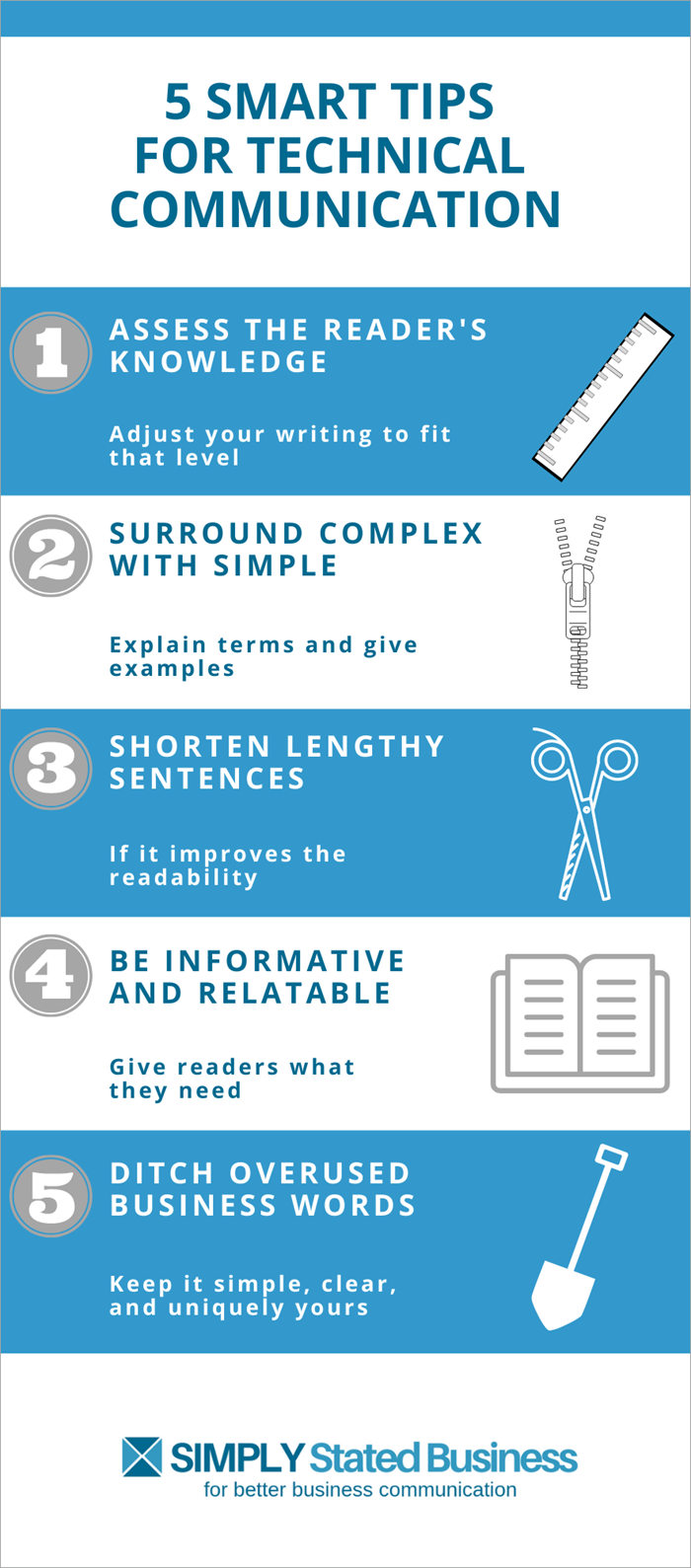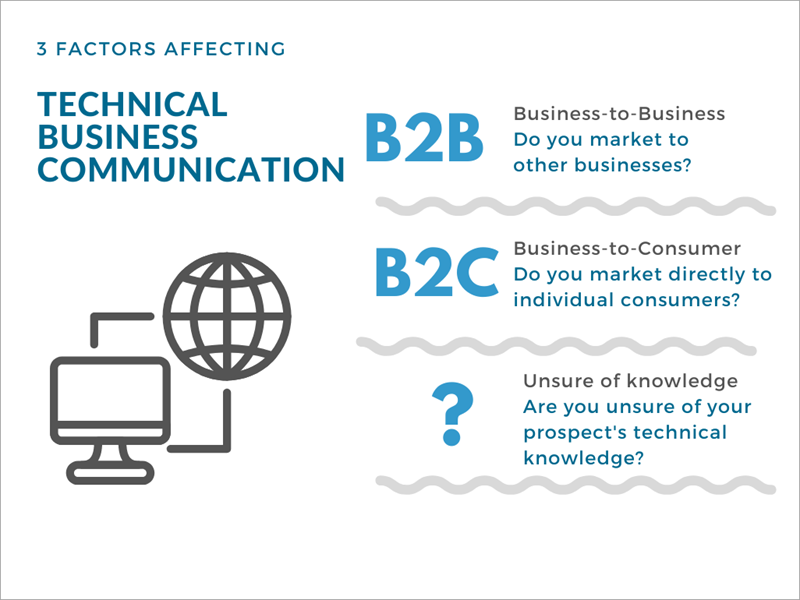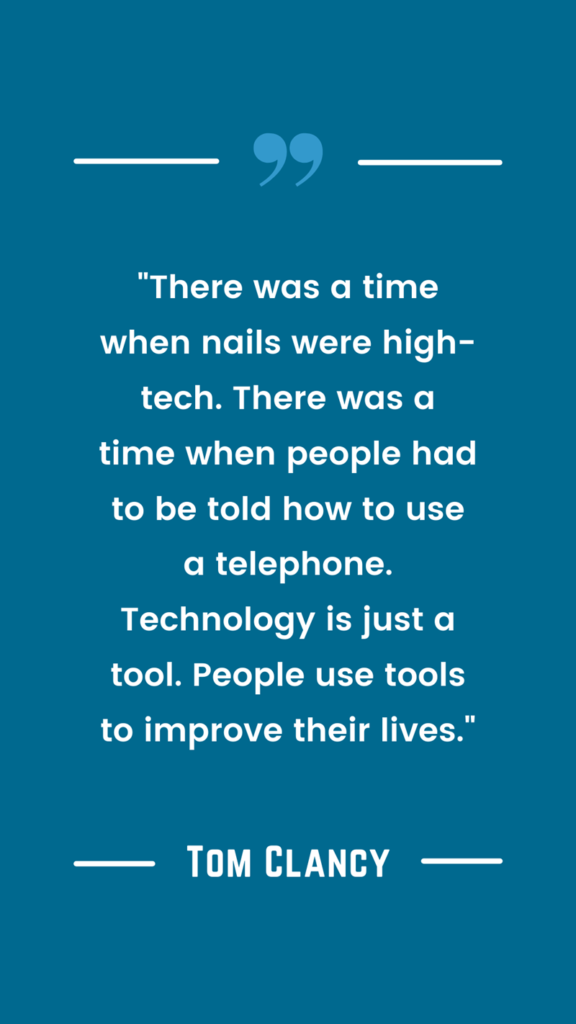 Are you in a highly competitive, technical field? You need to prove you know what you’re doing. You don’t want to dumb down your business communication too much, right?
Are you in a highly competitive, technical field? You need to prove you know what you’re doing. You don’t want to dumb down your business communication too much, right?
True. But do you know how much is too much?
Dumb Down Debate
Perhaps it’s the term that makes business communicators bristle when they are told to “dumb down” their content.
- Some find it insulting
- They feel it’s a hit to both the content writer and the customer
- Others argue technical writing needs to prove knowledge
So, how do you find the balance between credibility and boring blathering? The following 5 tips offer ideas for keeping it simple without sacrificing credibility. You can download a PDF version of the graphic.
Tip #1 – Assess the reader’s knowledge.
In a competitive market, it’s tough to stand out. One way to do that is proving your knowledge about the business. You demonstrate that through your business communication and conversations.
But what if your prospect is not on the same technical level? Content that is too technical may be lost on the very business you hope to gain. Before releasing your content, consider the following 3 factors that apply to your communication.
1. B2B Marketing
Imagine you were UPS, FedEx, or some other shipping company, back when you were pitching your services to Amazon. You probably did not need to explain the supply chain concept to Amazon.
- However, the carriers did need to demonstrate what was different about their services.
- They also needed to prove they understood the challenges of Amazon’s Prime delivery guarantees.
In the above scenario, the use of technical language would have been necessary, especially in a Request for Proposal bidding process.
- So, if you are a B2B operation, chances are, you won’t need to “dumb down” your business content too much.
- Or will you? Technical does not always equal complex content (more about this in Tip #2).
- On the other hand, if the two businesses are in different sectors, your prospect’s technical level may be in another area.
Let me give you an example.
During my corporate career, I worked with companies on their employee benefits, such as their health coverage. My primary contacts were typically human resources (HR) representative.
Outside vendors often pitched their technical platforms to streamline the administration of employee benefits. I saw more than one HR representative’s eyes glaze over when told the following.
- The vendor’s Enterprise Resource Planning (ERP) system was superior to older Legacy systems.
- Some HR staff had the technical knowledge to keep up, but many did not.
- That was especially true if the prospect was a small business without the technical resources.
How to Fix It
Lead with questions to assess the prospect’s knowledge level. You don’t want to put them on the spot with technical questions they may not be able to answer. Instead, ask about the effectiveness of their current system in helping them do their job.
For example:
- What has been your biggest pain in administering benefits with your current system?
- How have you attempted to fix the problem? (Their explanation gives clues to their technical knowledge).
- Have you explored other systems or solutions?
Adjust your communication to their level of understanding. Identify the benefits of your product in terms they can relate to (e.g., time saved, increased productivity, a more secure platform).
2. B2C Communications
If your business markets directly to individual consumers (e.g., an individual purchasing a laptop), it’s best to keep communication simple.
- Customers will possess different levels of technical knowledge.
- Consider segmenting communication in escalating levels of information.
- That way tech-savvy customers can skip basic information and access more detailed data.
3. Unknown Technical Knowledge
No matter if you are a B2B or B2C marketer, your potential buyer’s technical knowledge may be unknown to you.
In some cases (like the above HR example), you can determine how tech-savvy potential customers are by asking questions. However, there are times you will not know this information.
The solution is clear – Keep it simple.
Tip #2 – Surround complex with simple.
Have you ever noticed how technical terms are a magnet for complex words?
Sometimes you need complex or technical words. However, you can clear the path to understanding for more people by simplifying the surrounding words.
Scientists and health care professionals writing for their peers share complex and technical subjects. But that does not mean the entire piece needs to be wrapped in complex language.
Business Writing Blog offered the following example from a coaching session with a scientist on her writing.
Instead of…
“The results of this trial may elucidate the most efficacious intervention strategies…”
As Business Writing Blog notes, other than “intervention strategies,” the other complex words are not scientific in nature. So, why not try something simpler?
Try this…
“The results of this trial may uncover the most effective intervention strategies…”
Explain yourself
If you do use complex or technical terms, explain their meanings. You can do that literally (with a definition) or by providing an example or metaphor for the term.
Tip #3 – Shorten lengthy sentences (if it improves readability).
You want a good mix of sentence lengths.
- Too many short sentences end up sounding choppy.
- Overly long sentences drown your message or explanation.
- So, try reading aloud (or using software that does that for you).
Zero in on sentences that need trimming.
Tip #4 – Be informative and relatable.
The objective of technical communication is teaching potential customers about your product and what’s unique about it. Hopefully, their understanding will result in sales.
Good technical communication gives customers what they need (information) in a form they can relate to.
As discussed above, metaphors are a great way to aid understanding. Look at some of the common terms used to refer to parts of technology. They rose from metaphors.
- Port – transfer point for data – like a shipping point for products
- Search engine – drives through data to move answer to user – like an engine moves a vehicle
- Folder – holds multiple files of data – like a paper folder holds documents
Painting a picture for potential customers through metaphors and examples help them better understand a technical product or process. By being relatable, you help reduce their fear of trying something different.
Tip #5 – Ditch overused business words.
Technology has its own language. While some of that language has become commonplace, other terms leave customers with that dreaded blank stare.
- Make sure your potential client speaks the same language.
- Industry jargon or acronyms can confuse the reader.
- Try a fresh approach over worn out analogies and phrases.
“Best of breed” is an example of a phrase that has become tired.
- It began in the information technology field.
- That probably stole it from the dog breed world.
- It expanded to any business to mean the best product of its type.
Including tired, overused words and phrases is just as boring in technical writing as it is in any business communication.
Clear-Cut Winner Without the Dumb Down
Dumb down has such a negative sound to it. But if you focus on the intent – creating simple, clear communication – you can produce winning communication. Just look at the success of the For Dummies series.
- Figure out your reader’s technical level.
- Make the complex simple with examples and explanations.
- Remember readability – shorten sentences where it makes sense.
- Create content that informs while being something readers relate to.
- Avoid overused, tired language and terms only an insider would know.
What tips do you have for technical business communication that won’t dumb down your expertise? Please share your suggestions in Comments.
====================
Helping you Keep it simple, clear & uniquely yours
=====================




0 Comments